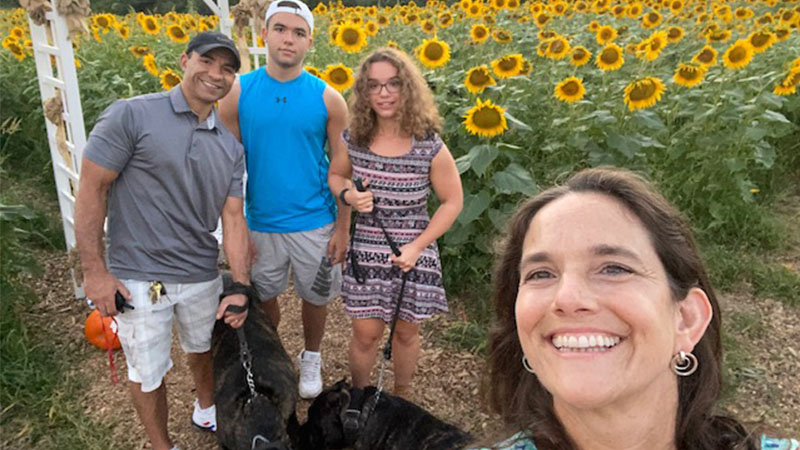
Participating in research offers her hope of changing the course of lung cancer
Jennifer Moran is married to her high school sweetheart. They have two teenage children in college. A photography major who once dreamed of working at National Geographic, she fell into “a wonderful career in ophthalmic photography.”
At age 48, she was diagnosed with stage 4 EGFR-positive non-small cell lung cancer (NSCLC).
“It was just a complete shock to hear that diagnosis,” said Moran. She emphasized that it took some time to wrap her head around the news. Then, she said, “I realized that, unfortunately, my story isn’t unique. There are so many young women, especially disproportionately under the age of 50, who are being diagnosed with late-stage lung cancer.”
Finding community—and inspiration.
After her diagnosis, Moran reached out online for support. She found not only a welcoming community but also inspiration. She keeps a scrapbook of what she’s done and the people and stories that have touched and inspired her.
“How can I contribute to this great list of all these people who have come before me?” she asked.
One answer: Participate in research.
“The more time and money that is put into lung cancer research, the longer people can live,” said Moran. “We have to keep pushing and advocating and raising awareness. And when we participate in research studies as lung cancer survivors, we help to turn lung cancer into a chronic illness that we can live with for years and years.”
This led Moran to enroll in the Epidemiology of Young Lung Cancer (EoYLC) study, a collaborative effort between GO2 for Lung Cancer, the Addario Lung Cancer Medical Institute and leading academic centers.
Finding the causes of young lung cancer.
The Epidemiology of Young Lung Cancer is looking to identify common risk factors among younger lung cancer patients to help researchers crack the code on a young lung cancer diagnosis. Eligible participants fill out a confidential, online survey and provide a small sample of blood. The EoYLC survey asks about a person’s demographics, medical history, lifestyle, and environmental and genetic risk factors. There’s also an option to take the birth mother’s medical history, which allowed Moran’s mother to contribute as well.
The study’s eligibility criteria were updated earlier this year to include people diagnosed with NSCLC in their 40s—making Moran eligible to participate.
The new age criteria (under 50) is still significantly younger than the average age of a lung cancer diagnosis in the U.S. (~age 70). The change allowed for a wider diversity of people to participate in the study without compromising the key scientific questions.
Moran, for one, is grateful the eligibility criteria were changed. “It’s important to be a part of the solution,” she said. And just like all the lung cancer survivors before her, she’s now the one “contributing to the [lung cancer] cause.”
Under 50 when you were diagnosed with lung cancer? Find out how you can participate in the Epidemiology of Young Lung Cancer study.
Under 50 when you were diagnosed with lung cancer? Find out how you can participate in the Epidemiology of Young Lung Cancer study.

[…] post Jennifer Moran on Finding Inspiration – and Inspiring Others appeared first on GO2 for Lung […]
Thanks for sharing your story Jen and for being an amazing cousin!